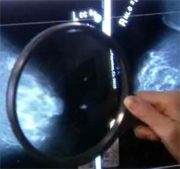
MONDAY, Oct. 1 (HealthDay News) — Cancer treatment could one day be more effective and less difficult to endure if an experimental breast cancer therapy that offers high-precision targeting of tumors proves successful.
The new approach uses a unique three-pronged combination of agents that simultaneously attack cancer cells but prevent the release of chemotherapy until the drug reaches its specific target, said the authors of a new study on the technique.
As a result, the treatment attacks cancer with greater power and effectiveness, yet less toxicity, so patients experience fewer side effects, such as nausea and vomiting, hair loss and infections, the study authors said.
The drug therapy, called T-DM1, appears to be effective in prolonging life and reducing tumor growth with less impact on the body’s healthy cells in a significant proportion of women in the late stages of a specific kind of breast cancer known as HER2-positive. It has not yet been approved by the U.S. Food and Drug Administration.
T-DM1 is what’s known as an “antibody-drug conjugate,” designed to deliver potent anti-cancer drugs to tumors while limiting toxicity to healthy cells in the body.
“This is a new model for attacking cancer,” explained study author Dr. Sunil Verma, a medical oncologist at Sunnybrook Odette Cancer Centre and an assistant professor at the University of Toronto. “It opens up the doors for antibody-drug conjugates to be used potentially with early-stage breast cancers, lung, colon and colorectal cancers,” he said.
Breast cancer is the most common female cancer in the United States. Up to 20 percent of women with breast cancer have tumors that have high levels of HER2, which is a protein that is involved in cell growth, differentiation and blood vessel formation, Verma said.
The experimental drug is made up of trastuzumab (Herceptin, an existing breast cancer drug) and the cancer-cell-destroying agent emtansine (DM1), plus a substance that prevents the drug from becoming active until it reaches the targeted cancer cells. Trastuzumab delivers DM1 to the tumor where it kills cells overproducing HER2, Verma explained.
By combining these components, T-DM1 targets cancer cells while minimizing harmful side effects, he said.
In the case of HER2-positive cancer, the antibody-drug conjugate includes Herceptin. But with other forms of cancer, the antibody could be different, depending on the genetic composition of the cancer, Verma explained.
The research was published online Oct. 1 in the New England Journal of Medicine and was scheduled for presentation Monday at the European Society for Medical Oncology, in Vienna.
In the study, a phase 3 trial, 991 patients with HER2-positive breast cancer were randomly assigned to receive either T-DM1 or standard therapy: the anti-cancer drugs lapatinib (Tykerb) and cepecitabine (Xeloda). All the participants had locally advanced or metastasized breast cancer previously treated with Herceptin and a taxane, a type of drug that blocks cell proliferation by stopping cell division, the study authors said.
Of the participants, 43.6 percent of those on T-DM1 had tumor shrinkage, while 30.8 percent of those on the other medications did. Mean progression-free survival was 9.6 months in the T-DM1 group compared with 6.4 months among those getting standard therapy.
“That’s significant,” said Verma. “And this improvement comes with less toxicity and fewer side effects.”
Dr. Daniel Hayes, clinical director of the breast oncology program at the University of Michigan Comprehensive Cancer Center, said the question is whether this three-pronged approach will be effective with other cancers.
“We don’t know yet, but it’s likely,” he said. “But people will definitely benefit from this drug.”
Hayes said that while science has made remarkable progress against breast cancer during the last 30 years, “we still have 30,000 to 40,000 women die of breast cancer every year. We need to do better.”
More information
To learn more about breast cancer, visit the U.S. National Cancer Institute.

